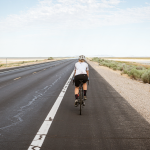Cycling might not be the most injury-prone sport, but when spending so many hours in the saddle – like many triathletes do – you can, despite the low impact, develop injuries. Those can include back pain, painful knees or stiff shoulders. The most important way to prevent these injuries is to make sure you prepare well and are well positioned on the bike. A good position can be dialed in through a bike fit with an expert. But there are a few things you can check yourself. Let’s go through the checklist!
Practice riding in an aero position for a long time
It is crucial for long-distance triathletes to practice staying in an aero position for a long time. If you have not ridden a time trial bike before, it is important that you take the time to get used to the aerodynamic position and that you have ridden up to 180 km mainly on the aero bars before the race. Athletes that haven’t practiced this enough might run into issues on race day. While you will probably get through the bike part, a painful back during the run could cause problems.
Relax
Keep your shoulders and arms as relaxed as possible. Tensed shoulders are a common problem for cyclists and can result in a painful and stiff neck. It’s also important to keep your arms a little bent when you hold onto the handlebars to help absorb road shock, too.
Knees and Feet
Most cyclists prefer to have their cleat positioned at the ball of the foot. Incorrect cleat positioning can lead to problems with your knees and feet. A bike fit is recommended to help you find the ideal cleat position, but you can do your own check by through your knee position: your knees should be in line with your feet when riding.
Saddle
One of the first things you adjust when hopping on a new bike is the saddle height. The right saddle height is very important to efficiently transfer power onto the pedals. If your saddle is too high you will move your hips a lot to try and reach the bottom of each pedal stroke. When the saddle is too low, on the other hand, people often start to feel pain in the front of their knees. The rule of thumb is that your leg should be slightly bent at the bottom of a pedal stroke.
Besides the height of your saddle, it is also important to figure out how much you should move your saddle forwards or backwards. Along with the length of the stem, this position determines how low you sit and how much you need to reach forward. If you experience back pain, and your saddle height is correct, you might be sitting too deep (too far back). Using a shorter stem, or moving your saddle a little forward, could be the solution.
Handlebars
The height of your handlebars also influences how low you sit on the bike. In general, lower means more aerodynamic, but if that comes with a price – injuries in this case – you will benefit more from a comfortable position than an aerodynamic one.
Frame size
Before buying a bike, make sure you know what frame size works best for you. While there are certain guidelines for height and the matching frame size, everyone is different. Some people prefer to ride a bike that is a little smaller than recommended. That’s why it’s good to do a test ride before investing in a new bike.



